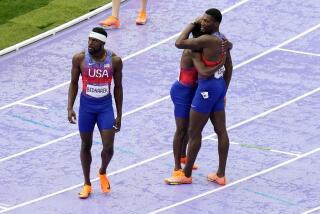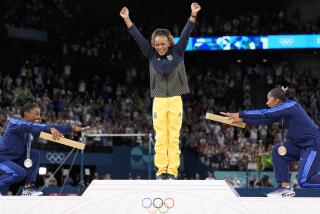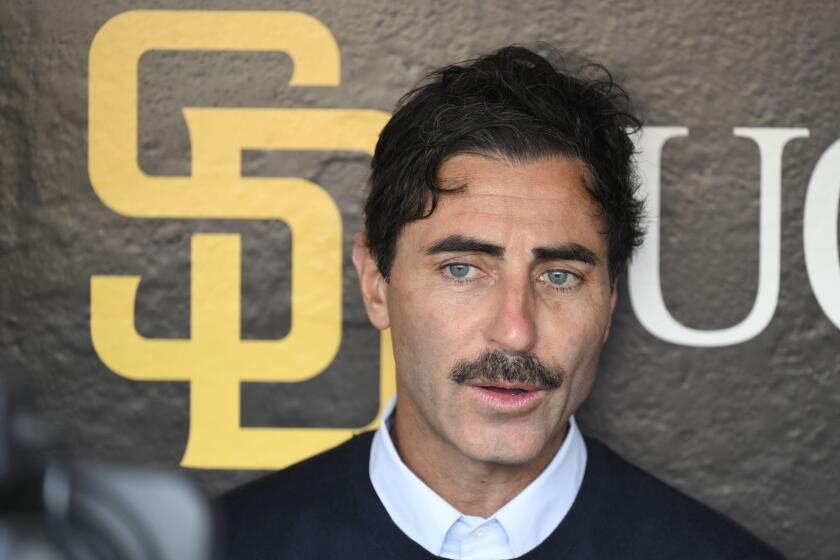Handoffs make for a wild ride in new luge relay event
For the last 50 years, lugers have toiled alone at the Olympics, with only themselves to blame if they flamed out.
That’s about to change.
The Sochi Games will mark the debut of the luge relay, an event that has become hugely popular with fans on the World Cup circuit because of its unpredictable nature and fast pace.
The participating countries will send three sleds — one female, one male and a doubles team — down the icy track, one after the other, as the clock ticks. At the end of each leg, the competitors must hit a time-sensitive pad to release the start gate and allow their teammate to begin the next run.
The team with the lowest combined time wins.
Just as in track’s 400-meter relay, luge handoffs are fraught with disqualification opportunities — and no one wants to be the athlete who drops the proverbial baton.
“It’s an exciting event,” veteran U.S. luger Christian Niccum said. “You have three sleds going down, so there are three chances of mishaps happening.”
A recent World Cup relay in Winterberg, Germany, showed just how wild the ride can be. The race featured three crashes, a false start, a missed hit on the time pad and a horribly botched run that left the home crowd stunned.
The Kazakhstani team tapped into the relay’s erratic nature early, as slider Tatiyana Nevzorova held up two hands to smack the uvula-shaped time pad hanging above the finish line and somehow zipped by without touching it. Her teammate Sergey Korzhnev, who was waiting in vain at the top of the track for the start gates to open, shook his head and smiled ruefully when officials announced why the team had been eliminated from the competition.
In the competition’s waning runs, the United States team sat in second place behind Italy with two luge relay powerhouses — Germany and Canada — still left to compete. Canada then made a rare misstep, as its doubles pair inadvertently touched the start gate and caused it to open before teammate Samuel Edney ended his run.
When the standings showed the team had been disqualified, Edney jokingly pretended to wipe tears from his eyes. The U.S. sliders, however, smiled broadly, knowing Canada’s bad luck had assured them both a medal and a considerable boost in the world rankings.
At that point, the Americans assumed it couldn’t do better than the bronze spot because the formidable German squad was up next and almost certainly would post a faster time. But Germany’s lead luger, reigning world champion Natalie Geisenberger, executed a terrible start that dropped her team to ninth place and ended her country’s 15-race podium streak.
When the final standings were posted, the shocked U.S. lugers stood at the bottom of the track with their hands over their mouths.
“We had a crazy race,” said Jayson Terdiman, who competed with Niccum in the doubles leg that day. “We had a great time and a little magic happened at the end.”
The Germans currently lead the overall World Cup team relay standings with 509 points after winning four gold medals in six events. Canada has 400 points, followed closely by the United States with 395.
All three countries should contend for a medal when they race at the Sanki Sliding Center, the new state-of-the-art track located in Rzhanaya Polyana, about 40 miles northeast of Sochi.
Though new to the Olympics, the mixed-team event has been a staple at the world championship competitions for nearly three decades. It became a relay event in 2008, when organizers ditched the simple combined time in favor of the touch pad and a running clock.
In Europe, the crowds and televisions audiences enjoy the relay as much as the individual and doubles events, U.S. sliders said. The race is shown on a split screen, so viewers can see both the current racer and the person waiting to begin the next leg.
“A lot of people don’t see mistakes with luge, at least big mistakes,” U.S. luger Chris Mazdzer said. “But for a team to be competitive, it has to be perfect for three minutes instead of one minute. There are a lot of chances for team to rise and fall — and that’s more appealing to the crowd than seeing the same run over and over again.”
The U.S. Luge Assn. will not select its relay members until after individual performances during the singles and doubles events. Per tradition, the race will be held on the final day of the luge competition.
The entire American team takes the event seriously, as the sliders regularly practice hitting the time pad and leaving the starting gates quickly. Fearful of having their spiked gloves stick to the pad and jamming their fingers as they fly by at 55 mph, U.S. sliders prefer to hit the pad with closed fists.
Though a few U.S. swimmers and speedskaters have skipped team events at the Olympics, the American sliders all want a spot on the relay.
The event offers more than just a chance at medal, Mazdzer said. It’s a chance to compete as a team, to not have to go it alone for once.
“In an individual sport, we’re not really able to share our individual success with others,” Mazdzer said. “So it’s fun to be able to share success with your teammates. It’s just nice to be part of team.”
Twitter: @stacystclair
/stacystclair”>@stacystclair
More to Read
Go beyond the scoreboard
Get the latest on L.A.'s teams in the daily Sports Report newsletter.
You may occasionally receive promotional content from the Los Angeles Times.










